This magazine is updated every weekend

|
The Arawaks
The first people the Columbus saw when arrived in Jamaica were a brown-skinned people
called the Arawaks. Fishermen in their canoes, cultivators clearing land, boys snaring
birds, all gazed with wonder at the strange ships whose great square sails 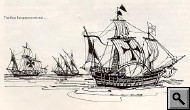 resembled the
wings of some enormous bird. Also watching was the grave and stately cacique, whose
crown of green, white, and red stones, and whose feathered cape, showed him to be their
leader.
resembled the
wings of some enormous bird. Also watching was the grave and stately cacique, whose
crown of green, white, and red stones, and whose feathered cape, showed him to be their
leader.
Those people were of middle height, plump in build, and had straight black hair which they usually wore long, and decorated with parrot feathers. Their foreheads were flat and sloping, for like the Maya, mothers bound their babies' heads between two boards in order to create this shape, which they found beautiful. All wondered about the tall, fair-skinned strangers, curious to know who they were, and what they wanted from the inhabitants of these tiny tropical islands.
For over fourteen hundred years the Indians had inhabited the mountainous and fertile islands of the Caribbean. At about the time of Jesus' birth they had left their original homes in Venezuela and had sailed up the Antilles, leaving groups to settle on each island in turn. Eventually they reached the Greater Antilles, and made their largest settlements on the islands of Cuba, Hispaniola, Puerto Rico, and Jamaica. There, they lived an untroubled life, fearing nothing but drought and hurricane, and sudden Carib raids.
The Arawaks lived in small scattered villages, sometimes near the sea, sometimes on a hill a few miles from the sea. Here they were ruled by their cacique, or chief, who was their law-maker, their judge, and their chief priest. The cacique inherited his position and was greatly respected by his tribe, whom he ruled with gentleness, courtesy, and firmness, for all villagers had to obey his commands. If he left no heir, the eldest son of his eldest sister would become cacique.
The Arawaks had few laws, however. They owned most things in common except personal
possessions like stone tools, clay pots and canoes. The greatest crime among them was
theft, for which the penalty was death by impalement (being pierced with a sharpened stick
and left to die). The cacique's main duties were to organise the work of 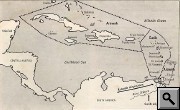 the village. This
was done on a cooperative basis, with everyone sharing in the work to provide the tribe's
needs. The cacique decided when the fields should be planted, and when new ones should be
cleared. The mitaymos, or nobles, supervised the work, while the commoners cleared
the bush, or cut down the trees for the all important canoes. The cacique also decided
whether or not to attack a neighbouring tribe, for the Arawaks were not always peaceful.
Above all, he led his people in the many festivals and religious ceremonies.
the village. This
was done on a cooperative basis, with everyone sharing in the work to provide the tribe's
needs. The cacique decided when the fields should be planted, and when new ones should be
cleared. The mitaymos, or nobles, supervised the work, while the commoners cleared
the bush, or cut down the trees for the all important canoes. The cacique also decided
whether or not to attack a neighbouring tribe, for the Arawaks were not always peaceful.
Above all, he led his people in the many festivals and religious ceremonies.
Festivals and everyday life
Many festivals marked the Arawak year, some religious and some not. For example, the
naming of a baby was a time of rejoicing, for the Arawaks felt a child without a name
would meet with great misfortune. The everyday activities of the Arawaks centred around
providing food and shelter. The women were responsible for preparing the food. Since 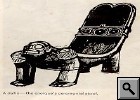 the main food was
cassava, which is poisonous in its natural state, preparing it required very great care.
First the root was grated on a board covered with small pebbles or rough coral until it
formed a paste. This was put into a wicker tube, one end of which was hung from a branch,
while a weight was attached to the other end. This caused the tube to contract, and forced
the poisonous liquid out through the wicker. The paste which remained was left to dry and
then pounded into flour using a stone mortar and pestle. The flour was formed into flat
cakes and baked on a clay griddle until the cakes were hard and dry. The Arawaks also made
a very tasty pepperpot where into a large clay pot were put cassava juice, from which
poison had been extracted, and beans, peanuts, potato, and some meat, perhaps iguana, or
turtle, or yellow snake, and pepper. The family was fed three times a day, and as some
pepperpot was removed more ingredients were added so that the delicious soup was already
ready.
the main food was
cassava, which is poisonous in its natural state, preparing it required very great care.
First the root was grated on a board covered with small pebbles or rough coral until it
formed a paste. This was put into a wicker tube, one end of which was hung from a branch,
while a weight was attached to the other end. This caused the tube to contract, and forced
the poisonous liquid out through the wicker. The paste which remained was left to dry and
then pounded into flour using a stone mortar and pestle. The flour was formed into flat
cakes and baked on a clay griddle until the cakes were hard and dry. The Arawaks also made
a very tasty pepperpot where into a large clay pot were put cassava juice, from which
poison had been extracted, and beans, peanuts, potato, and some meat, perhaps iguana, or
turtle, or yellow snake, and pepper. The family was fed three times a day, and as some
pepperpot was removed more ingredients were added so that the delicious soup was already
ready.
Fishing
The men caught fish and meat for the family. They made canoes from which they fished
and were responsible for building their own homes and stone tools. Canoes were 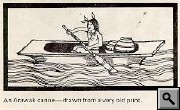 dug out and shaped from large
cedar or silk cotton trees some of which were as long as 80 feet and the Arawaks could
travel great distances in them paddling from island to island to barter goods.
dug out and shaped from large
cedar or silk cotton trees some of which were as long as 80 feet and the Arawaks could
travel great distances in them paddling from island to island to barter goods.
Arawak housing
Making houses was another of the men's tasks. Some of these were very large. They were
bell-shaped, and housed about a hundred people. In all Arawak settlements
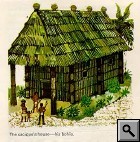 several families shared one house, which
was called a caneye. It was round, and made of wattle with a thatched roof. Sometimes it
had windows, but not always, and there was almost never a smokehole. However, these houses
were very sturdily built especially since they had to withstand hurricanes. Wooden posts
were placed firmly in the ground to
several families shared one house, which
was called a caneye. It was round, and made of wattle with a thatched roof. Sometimes it
had windows, but not always, and there was almost never a smokehole. However, these houses
were very sturdily built especially since they had to withstand hurricanes. Wooden posts
were placed firmly in the ground to 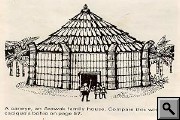 form a circle about five paces apart and laced together with withes and grass. These
Arawak houses were cool, rain proof and windproof and need never be replaced if they were
well built.
form a circle about five paces apart and laced together with withes and grass. These
Arawak houses were cool, rain proof and windproof and need never be replaced if they were
well built.
The word Maroon comes from the Spanish word cimarron which means wild: untamed.
They were slaves who either ran away from or were released by the Spanish 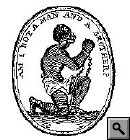 before the English invaded Jamaica
in 1655. They were successful, in retaining their independence for a 150 years of slavery
by constantly defending their freedom. Their settlements were small not more than 2,000
strong but they fought as if they were in greater numbers.
before the English invaded Jamaica
in 1655. They were successful, in retaining their independence for a 150 years of slavery
by constantly defending their freedom. Their settlements were small not more than 2,000
strong but they fought as if they were in greater numbers.
Slaves belonging to Spaniards joined in guerrilla warfare against the invaders. In 1685 a group of these, under Juan de Bolas, made a treaty with the English. From this time on they were joined by runaways from English masters, while others formed their own separate bands. By 1720 there were two distinct groups of Maroons one in the centre of the island and the other in the northeast.
The First Maroon War
In 1731 there was started what has become known as the First Maroon War. It
lasted on and off for eight years, though in fact it really began in 1655 and continued
for 84 years. In 1739-40 the British government in Jamaica, since it could not defeat
these warriors, came to an agreement with them. They were to remain in their five 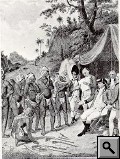 main towns (Accompong, Trelawny Town, Moore
Town, Scots Hall, Nanny Town), living under their own chief and a British supervisor. In
exchange, they were asked to agree not to harbour new runaway slaves, but rather to help
catch them. This last clause in the treaty, as you can imagine, caused a split between the
Maroons and the rest to the black population, although from time to time runaways from the
plantations still found their way in the Maroon settlements.
main towns (Accompong, Trelawny Town, Moore
Town, Scots Hall, Nanny Town), living under their own chief and a British supervisor. In
exchange, they were asked to agree not to harbour new runaway slaves, but rather to help
catch them. This last clause in the treaty, as you can imagine, caused a split between the
Maroons and the rest to the black population, although from time to time runaways from the
plantations still found their way in the Maroon settlements.
The person responsible for the compromise with the British was the Maroon leader,
Cudjoe, a short, almost dwarf-like man who for years fought skillfully and bravely to
maintain his people's independence. As he grew older, 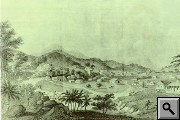 however, Cudjoe became increasingly
disillusioned. He ran into quarrels with his lieutenants and with other Maroon groups. He
felt that the only hope for the future was honorable peace with the enemy, which was just
what the British were also thinking. The 1739 treaty should be seen in this light. A year
later, the even more rebellious Trewlany Town Maroons also agreed to sign a treaty
though they were never happy about it.
however, Cudjoe became increasingly
disillusioned. He ran into quarrels with his lieutenants and with other Maroon groups. He
felt that the only hope for the future was honorable peace with the enemy, which was just
what the British were also thinking. The 1739 treaty should be seen in this light. A year
later, the even more rebellious Trewlany Town Maroons also agreed to sign a treaty
though they were never happy about it.
The Second Maroon War
In 1795 these Trewlany Town Maroons declared war for a second time against the British. They felt that they were being badly treated under the terms of the treaty. They especially felt that the land allotted to them for farming was rocky and inadequate. After the years of fighting in which time and time again they defeated the much larger forces sent against them, they were persuaded to come to terms. They found themselves tricked and instead of obtaining a revision of treaty, they were all of them old and men, warriors, women and children transported to cold Nova Scotia, and after a few years sent to the new British settlement of Sierra Leone in West Africa. The other Maroon towns did not take part in this rebellion, however, and their treaty with the British remained in force until Jamaica gained its independence in 1962.
Other forms of resistance
Apart from running away and forming Maroon settlements, the slaves had many other ways of showing their dislike and hatred of the regime. Some ran away, not to join Maroon or rebel groups, but simply to do something else. Some of these pretended to be free and got away with it; others simply took up jobs in towns or became fishermen or woodcutters, which gave them virtual freedom.
Those who did not run away had other means of reacting against their servitude. They could 'go slow', pretending to be lazy. They could pretend to be stupid. They could damage the horses, the oxen or the plantation equipment their masters. Many poisoned themselves. And thousands committed themselves to open violent rebellion. The Maroons fought and won battles against the British and in the end won their freedom.
Created by
The House of David
|

